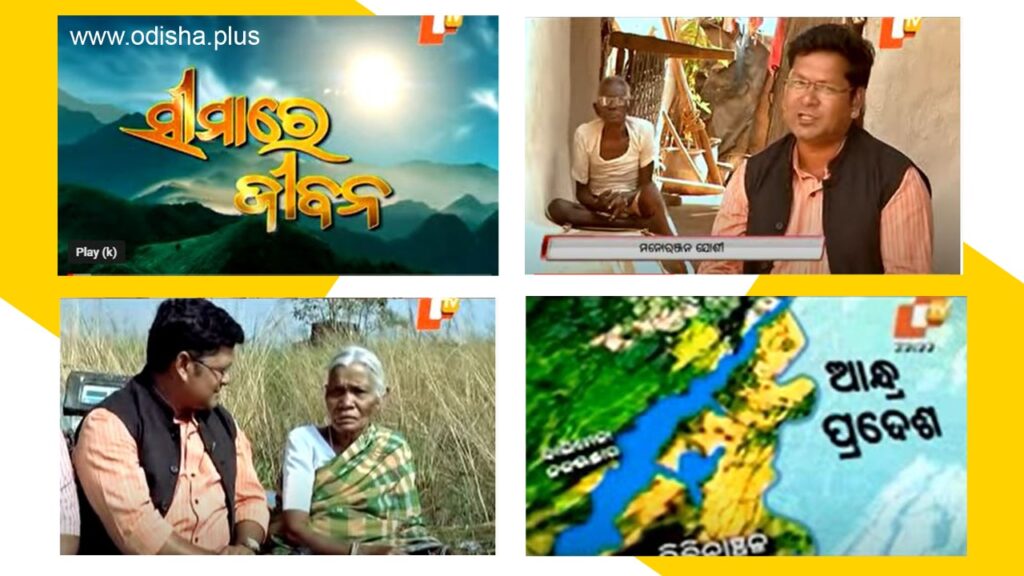Dr. Fakira Mohan Nahak
THE TELEVISION NEWS INDUSTRY IN ODISHA HAS GONE THROUGH A PROGRESSIVE JOURNEY IN THE PAST TWO DECADES. IN THIS SERIES DR. FAKIRA MOHAN NAHAK PRESENTS THE MEDIA HISTORY BLENDED WITH HIS CLOSE OBSERVATION ON THE FAST-CHANGING INDUSTRY.
Life in the border areas is always full of challenges. If it’s near to the international border, the Jawans of the country are vigilant round the clock, guarding the border day and night to make sure the people have a good night sleep. When it’s about state borders, the set of challenges are bit different. Every border area between two or multiple states poses its own set of obstacles to its inhabitants. People in the border areas face a lot of struggle unlike their counterparts in the mainland. They are far from the mainstream of society. People who have divided a piece of land on paper and map have never seen that the border of a state have crossed in the middle of a village. As a result, while one part of the village is in one state, the other part is in a neighbouring state.
The people of Odisha in its border areas have their own stories of struggle, deprivation, administrative negligence, language problem and what not. Our state Odisha is bordered by Andhra Pradesh in the south, Chhattisgarh in the west, Jharkhand in the north and West Bengal in the northeast, except for the 480 km long coastline in the east.

OTV took an innovative initiative and started a special program called “Seemare Jeevan” ( Life in the boarder) to find out how the people in the various villages of these regions are living, how far the various schemes of the state government are reaching them and how satisfied the people are with the various initiatives of the government.
This program was prepared by going to different villages in the different borders of the state and taking into account the lifestyle, movements, daily obstacles, problems etc. of the people living in the border areas. In 2014, the program was presented by Manoranjan Joshi. OTV cameraman Sunil Pradhan was in charge of its planning, preparation and production. It was a tough lesson to prepare the program by going to the villages on the various borders of the state amid many casualties. However, Manoranjan successfully brought many unexplored issues from those villages to the people.

Among the various reporting assignments he has done in his lifetime, says senior journalist Manoranjan, “Seemare Jeevan” was the best. He says it has made a difference in his journalism career and life.
The campaign for the program was launched from Chitrakonda in the border of Odisha and Andhra Pradesh. This area still remains unreachable as far as government facilities are concerned. Far away from the nearest city, surrounded by water reservoir, the people feel as if they have imprisoned themselves. Such are the villages of Darlabeda and Jodaamba. If they suddenly need something, they have to cross the reservoir and go to Chitrakonda. It takes about six hours for them to cross such a huge reservoir of water. Residents in the locality are deprived of all basic amenities.
In other words, these areas are ignored by the government officials and the people here are ignored by the mainstream of the society and the area remains Naxal dominated. Whether or not there is any commutable road or any other sign in the sprawling forest, there is bound to be a Martyr Memorial stone of Naxals. People may face difficulties in reaching their state or district headquarters in this area, but Andhra Pradesh for them is easily accessible. So they prefer to reach to the Andhra authorities for all their queries or concerns.
Health workers, teachers, gramsevaks, tehsildars or any other government officials hardly bother to visit these remote places and perform their duties. School opens only four days in a year on Ganesh Puja, Sripanchami, Independence Day and Republic Day. The rest of the days the children go to school and play in the school premises.
About 95 per cent of the people living in these areas have never seen the district headquarter in their lives. Seeing the picture of development in this area is definitely like a daydream. While this program was prepared and broadcast on OTV, the Gurupriya Bridge which wasthe long-standing demand of the local people was not yet constructed. And now, after the construction of the bridge, it can be said that there has been a slight change in the picture of development.

The Seemare Jeevan team also reported about the Bonda tribe, an indigenous group of people in Malkangiri district, near to the border of Andhra Pradesh. Even after a lot of efforts, planning and funding, the area is far from the development. Manoranjan and his team presented the day-to-day life style and struggle of the people from Mudulipada in the Bondaghatiarea and Badabil village in the borderarea. Similarly, while reporting on the lifestyle of the people living in the Sunabeda sanctuary in Nuapada district on the border of Chhattisgarh, the team had to face the Naxalites. In other words, the Naxals let them report in their own presence.
Every movement of the OTV team was monitored by the Red Force stationed there. However, the most heartbreaking was the picture of Jamapali village in Lakhanpur block of Jharsuguda bordering Chhattisgarh. The people of this once prosperous village were forced to leave their houses overnight on government orders. Displacement has occurred, but without proper resettlement and rehabilitation. Few have got the documents without the land.
Those who were in their early teens at the time of the displacement are now octogenarians. While doing the coverage, Manoranjan took an elderly aunt on a boat and went into the vast waters of Hirakud. The aunt was crying seeing houses, temples and schools submerged in the water. She used to wipe tears from her eyes and talk about how various festivals and processions were celebrated in her village before the construction of the reservoir. She kept talking about how prosperous her lifestyle was. If you look at their miserable life today, the genuine question comes to the mind that what is the meaning of such a development, which can remove the smile from the faces of others?
Not only that, the team has also visited the villages on the West Bengal border to present the problems of the people living there to the whole world. It’s not just that people in the suburbs or inner-city areas are at a disadvantage. The problem is similar in the border areas along the state highways. Border is on the middle road of the village. Left side of the street is in Odisha whereas the right side of the street is in West Bengal.
Some people’s houses are in Odisha, and the land behind the house is in West Bengal. In such a situation, when the Odisha government announces any scheme to help the farmers, they do not get it because their land is in West Bengal. Similarly, if the West Bengal government announces any public welfare scheme, then they are deprived of that too because in the record they are residents of Odisha.The biggest problem for the people in this area is the Tehsil system. While students get primary education in Odia in the village, they have to go to nearby West Bengal school in to study high school in Bangla. Similarly while students do plus two in Odia, they study degree in Bengali. As a result, these students often face problems in getting jobs.
According to Manoranjan Joshi, who has prepared this program by reporting from the border areas of the state, neither the state government nor the central government, no one has been able to keep them together. Rather, Lord Sri Jagannath has connected them with Odisha because whether there is anything or not in all these villages of border, the temple of Mahaprabhu Sri Jagannath is definitely there. People have an emotional connection with the Lord. It has become the main thread to tie everyone together with Odisha.
Although the language, culture, food, social life, customs and lifestyle of all these regions are different, they are an integral part of Odisha only because of Mahaprabhu. The team has also presented some images of Jagannath temple during the preparation of the programme. It was also observed that while the villages inside the border, that is, our state, were in a miserable condition, the villages of the neighbouring states across the border are very prosperous. This means that we are not giving enough importance to our border areas. So it is quite normal for the residents to feel neglected.
While reporting in the innermost areas and suburbs, Manoranjan and his colleagues had to walk 15 to 17 kilometres a day. As a result, he has to miss lunch for many days because many times they have not found anything to eat in those areas. They have to manage with biscuits and water. Many times there is no proper accommodation or resting place to spend the night. As a result, Manoranjan and his accomplices have to spend the night in someone’s house or school’s veranda.
All in all, the program that OTV produced to address the issues of people living on the border is a milestone in the field of development journalism. Such a program cannot be prepared by spending money alone. It requires a lot of determination, addiction, studyand hard work. Without proper research, it will not be easy to prepare such a program. The first episode of the program “SeemareJeevan” was aired on 19th October 2014 and the last and 17th episode was on air on 8th February 2015.
(Dr. Fakira Mohan Nahak is a writer and former media professional. He is currently working as the Head of the Department of University Institute of Media Studies, Chandigarh University at Mohali, Punjab. Views are Personal)
Tags: #SeemareJeevan #LifeInBorders #Odisha #developmentjournalism #ChhattisgarhJharkhandBorder #OTVNews #DevelopmentNews #LivelihoodNews




























